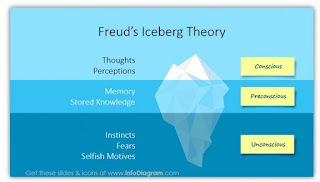Freud's Theory of Self and Personality.
Freud's Psychoanalytical Theory of Self and Personality Within Relation to Cinema and Film.
What is Freud's theory?
Sigmund Freud is seen as a founding father of psychoanalytic study, or study of the human mind and the way that it functions. Freud's "psychoanalytic theory of personality argues that human behaviour is the result of the interaction between three component parts of the mind: the id, the ego and the superego" (Karen Horney, 2015). According to "The Ego and The Id" (Sigmund Freud, 1923), the human personality develops from interactions between these three fundamental structures of the mind.
- the Id- the most primitive of the structures, the Id is concerned only with the instant gratification of basic and primitive needs and urges such as sex and desire. The Id operates unconciously meaning that we have no control over it.
- the Ego- the Ego is the rational and pragmatic part of the human psyche; it is less primitive than the Id and operates in a semi-conscious state. The Ego is what Freud considered to be the 'self' and serves to balance the desires of the Id and Superego within practical contexts of reality.
- the Superego- regarded as the moral compass or conscience of the human mind, the Superego is concerned with social rules and morals, usually learned from parents or elders as a child develops in accordance with what their culture deems as right or wrong.
Freud's studies concluded that the Id, the Ego and the Superego are in a state of constant conflict and that adult behaviour and personality are formed in the results of these internal conflicts during childhood. Freud also established through this, the stages of psychosexual development which shapes the personality from birth to adulthood based on experiences.
Relating Freudian Theory to Film...
In the majority of cases, films do not seek to specifically follow a psychoanalytical process or theory, but rather portray similarities to psychological theory through narrative or characters. Particularly, Sigmund Freud's theory is relatable to most narratives within cinema, due to the thematic preference for antagonists versus protagonists and also due to the fact that all films in some way seek to portray the human psyche and personality in a certain light within relation to genre.
Superhero / Comic Book influenced productions are a good example of films which display elements of Freud's theory clearly and inherently due to the nature of their narrative. For example, in Christopher Nolan's "Dark Knight" (2008), there is a clear example of the three components of the human personality within the characters and the narrative; Batman is a representation of the Id as he is reckless and impulsive, Bruce Wayne is the ego and Alfred the superego, guiding Bruce's moral compass.
Bibliography:
- Freud, S., (1923), The Ego and the Id,
- Horney, K., (2015), Psychodnamic Perspectives on Personality, Lumen Candela, available from: https://courses.lumenlearning.com/boundless-psychology/chapter/psychodynamic-perspectives-on-personality/
- McLeod, S., (2019), Freud's Psychosexual Stages of Development, Simply Psychology, available from:https://www.simplypsychology.org/psychosexual.html



Comments
Post a Comment